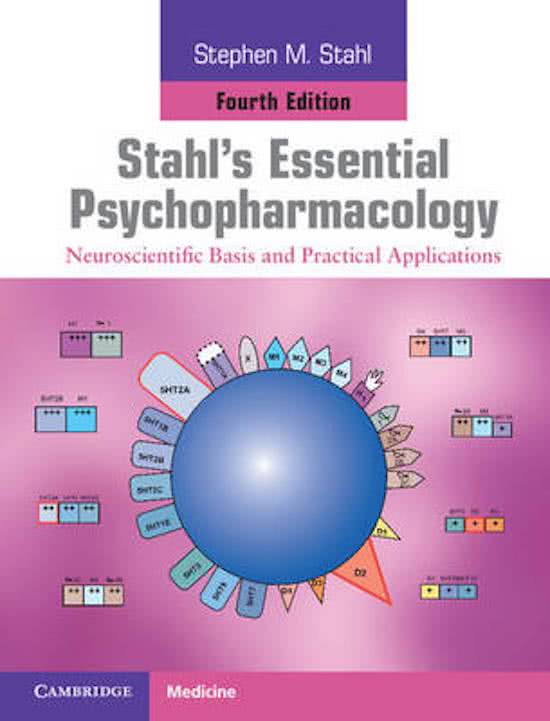Content
Week 1………………………………………………………………………………………...2
CH1: Chemical neurotransmission…………………………………………………………….2
CH2: Transporters, receptors, and enzymes as targets of psychopharmacological drug action...8
CH3: Ion channels as targets of psychopharmacological drug action…………………………10
Week 2……………………………………………………………………………………….10
CH4: Psychosis and schizophrenia…………………………………………………………10
CH5: Antipsychotic agents…………………………………………………………………13
CH6: Mood disorders…………………………………………………………………………15
CH7: Antidepressants………………………………………………………………………...19
Week 3………..……………...………………………………………………………………20
CH9: Anxiety disorders and anxiolytics……………………………………………………...20
CH14: Impulsivity, compulsivity, and addiction……………………………………………23
1
,Week 1
CH1: Chemical neurotransmission
Neurons and synapses form the anatomical basis of neurotransmission. However,
neurotransmission is mainly a chemical process. The most important neurotransmitters
are serotonin (5-HT; a monoamine; slow), norepinephrine (NE; a monoamine; slow),
dopamine (DA; a monoamine; slow), acetylcholine (ACh; an amine; slow), glutamate
(amino acid; fast), and GABA (amino acid; fast). These are often targeted by psychotropic
drugs.
There are a few special types of neurons. One special type are the pyramidal neurons (A).
These have a triangular cell body, one axon, and are generally stimulating. They can be
found in the prefrontal cortex, hippocampus, and entorhinal cortex. Pyramidal neurons
are involved in executive function and memory. Chandelier neurons (B) are another
special type of neuron. They look like chandeliers, have axoaxonic connections, and have
inhibiting effects on pyramidal cells. They can be found in the cortex. Spiny neurons (C)
are the third type. They have dendrites shaped like spikes, long axons, and can be found in
the striatum. Yet another special group of neurons are the purkinje cells (D). They have
dendrites shaped like a tree, one axon, and can be found in the cerebellum. The fifth group
of special neurons is comprised of interneurons (E). There are two types of interneurons;
local (short axons that analyse small pieces of information) and relay (long axons that travel
over brain regions). Interneurons provide a connection between sensory and motor neurons.
The final two are both inhibitory interneurons that can be found in the cortex. These are the
basket cells (F) and the double bouquet cells (G). Basket cells have dendrites shaped like a
basket and double bouquet cells have dendrites shaped like two bouquets.
A. B.
2
, C. D.
E. F.
G.
3






